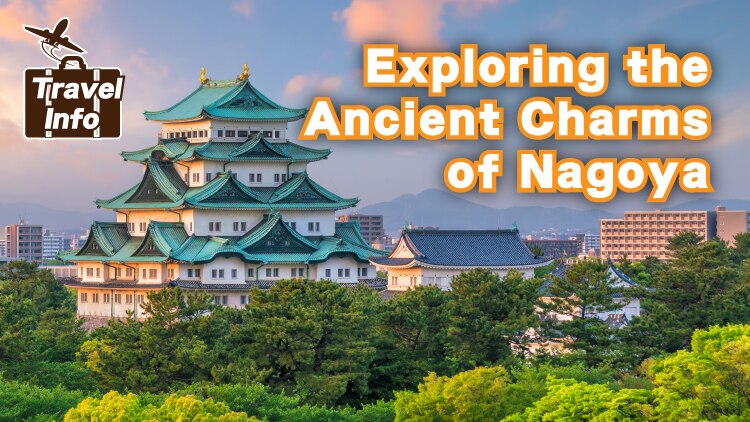

Exploring the Ancient Charms of Nagoya
For a holiday revisit to Japan, the second home of many Hong Kongers, consider a trip to Nagoya to experience the historical atmosphere of Japan's third-largest city. This article will introduce a series of attractions that allow travelers to immerse themselves in Japan's rich history and culture.
Before embarking on a shopping spree in Japan, be sure to prepare a large-capacity suitcase to bring back your trophies to Hong Kong. Don't forget to pack travel data, electronic device chargers, and adapters to ensure your journey is full of power and data, enabling you to enjoy the pleasures of travel without a hitch.
Osu Kannon - Blessings of Peace and Safety

Located in the central district of Nagoya, Osu Kannon was first built in 1333 and was originally situated in the Osu Village of Gifu Prefecture. To prevent frequent flooding from damaging the temple, Tokugawa Ieyasu, the shogun of the Edo period, ordered the temple to be relocated to Nagoya. The Osu Kannon seen today was reconstructed in the 20th century, as the original buildings were mostly destroyed by fire. However, a miraculous wooden Kannon statue survived the fire and became the current object of worship, blessing visitors with safety, peace, prosperity, and success in various aspects of life. When visiting Nagoya, it's a must to pay your respects to this auspicious Kannon statue and offer blessings for yourself and loved ones. After visiting the temple, you can explore the nearby Osu Shopping Street, a bustling marketplace that dates back to the Edo era. Besides shopping, you can also sense the historical ambiance of this ancient city.
Within the ancient city, every step feels as picturesque as scenes from a drama series. To capture the beauty of the ancient city, it's essential to carry a lightweight and portable camera.
Tokugawa Garden - Immersed in Samurai Culture

Nagoya was the birthplace of the Tokugawa family, one of Japan's three major samurai clans. Tokugawa Garden was the former residence of the samurai. In this traditional Japanese garden, visitors can enjoy the view of plum blossoms in February and March, cherry blossoms in March and April, and maple leaves in November, allowing visitors to immerse themselves in the flourishing culture of Japan's Edo period. Next to the garden is the Tokugawa Art Museum, exhibiting over 12,000 samurai-related items, including swords, armor, Noh theater costumes, and lacquerware. Nine of these items have even been designated as national treasures. For a deeper understanding of Japan's rich samurai history and culture, don't miss out on Tokugawa Garden and the Tokugawa Art Museum.
Wandering through the ancient city requires a comfortable travel backpack that can carry your essentials for the day. Note that you can hardly find trash bins on Japan's streets, so bring small garbage bags to store your trash in your backpack until you return to your hotel to keep the streets clean.
Nagoya Castle - Symbol of the City

Nagoya Castle stands as a symbol of the city. Originally constructed in the 17th century, it was destroyed during World War II and later rebuilt in 1959. The castle's main tower houses historical artifacts and relics from its history, some of which survived the war. Atop the castle, two golden dolphins are believed to protect it from fires. To catch a glimpse of these dolphins, head to the exhibition hall on the main tower and admire their life-sized replicas. The castle takes on a different charm in various seasons, such as cherry blossoms in April, maple leaves in November, and summer and year-end festivals. To fully experience Nagoya Castle, pay attention to its changing landscapes and festivals throughout the year.
The summer seasons in Japan be quite hot. To stay cool, consider packing items like portable cooler and fans to keep your body comfortable.
Atsuta-jingu Shrine - One of Japan's Most Important Shrines

Atsuta-jingu Shrine is one of Japan's three major shrines, steeped in mythology. It is said to house the Three Sacred Treasures of Japan: the Kusanagi-no-Tsurugi (Grass-Cutting Sword), the Yasakani no Magatama (Jewel Comma), and the Yata no Kagami (Mirror of Yata). The shrine also has a thousand-year-old sacred tree said to be inhabited by a white snake. Nestled within a forest, Atsuta-jingu offers a serene atmosphere surrounded by towering trees. Besides the main shrine, various smaller shrines are scattered throughout the grove, each with its own legend and story waiting to be discovered by visitors. Whether for prayers or to admire the solemn atmosphere, Atsuta-jingu Shrine is a must-visit destination.
For a relaxed and picture-perfect appearance while traveling, be sure to bring suitable personal care products like portable hair dryers, ion combs, and hair straighteners. Packing them won't take up much space in your suitcase, and grooming yourself on the go is made easy.
Tokoname Ceramic Walking Trail - Exploring Local Traditional Ceramic Craft

When it comes to traditional crafts in Japan, the widely recognized Maneki-neko (beckoning cat) figurines exported around the world can't be overlooked. Tokoname City in Aichi Prefecture is one of Japan's most historic and renowned pottery production areas, known as the birthplace of 'Tokoname-yaki' ceramics. It's even referred to as the 'Hometown of Maneki-neko,' and the quantity of these beckoning cat figurines produced here annually surpasses the rest of Japan. The highlight of the Tokoname Ceramic Walking Trail is undoubtedly the gigantic Maneki-neko statue. Standing as tall as a two-story building, it features the typical Tokoname characteristics of large ears, a round face, and big eyes, making it the most common portrayal of the Maneki-neko in Tokoname style. To catch a glimpse of the origin of these figurines and witness the Tokoname ceramics being made, a visit to the Tokoname Ceramic Walking Trail is a must. Remember to bring the selfie stick for taking IG-able pictures with the Maneki-neko!

